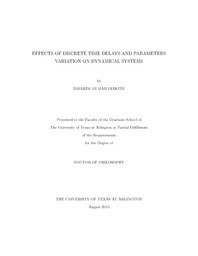
ATTENTION: The works hosted here are being migrated to a new repository that will consolidate resources, improve discoverability, and better show UTA's research impact on the global community. We will update authors as the migration progresses. Please see MavMatrix for more information.
Show simple item record
| dc.contributor.author | Diakite, Ibrahim Oumar | en_US |
| dc.date.accessioned | 2013-10-23T00:00:27Z | |
| dc.date.available | 2013-10-23T00:00:27Z | |
| dc.date.issued | 2013-10-23 | |
| dc.date.submitted | January 2013 | en_US |
| dc.identifier.other | DISS-12288 | en_US |
| dc.identifier.uri | http://hdl.handle.net/10106/23952 | |
| dc.description.abstract | To understand the effects of discrete time delays and of parameters variation on certain biological system models, we first consider a Delay Differential Equation model of human immunodeficiency virus (HIV). We investigate the effects of the discrete time on the virulence of the HIV strain, and present sufficient and necessary condition for the virulence of the pathogen to change as the time delay changes. We also consider the same delay differential model for HIV infection, and we investigate analytically and numerically the stability of the endemically infected equilibrium. Our analysis shows that certain key parameters, such as the rate of infection, play a crucial role on how the discrete time may affect the dynamics of the system. We carry out a bifurcation analysis of systems of delay differential equations. We present general results for one equation with one and two delays and study a specific example of one equation with one delay. We then establish the procedure for n equations with multiple delays and do a specific example for two equations with two delays. We investigate the stability of the steady states as both chosen bifurcation parameters, the discrete time delay and a local equation parameter, cross critical values. Our analysis shows that while changes in both parameters can destabilize the steady state, the discrete time delay can cause stability switches of the steady state for certain values of, while the effects of the local equation parameter on the steady state do not necessarily depend on the value of . While may cause the system to go through different type of bifurcations, the discrete time delay can only introduce a Hopf bifurcation for certain values of . We finally consider a delay partial di erential equation of a Holling type predator-prey model. It is well known that the distribution of species is generally heterogeneous spatially, and therefore the species will migrate towards regions of lower population density to increase the possibility of survival. Thus, partial differential equations with delay became the subject of a considerable interest in recent years. We consider, simultaneously, time delays and spatial diffusion to model the predator prey model presented in chapter 4. The discrete time delays are introduced in order to consider the time maturation for both the predator and prey populations. We mainly investigate, analytically and numerically, the errects of the spatial diffusion, the time delays and parameters variation on the dynamics of the system. | en_US |
| dc.description.sponsorship | Chen-charpentier, Benito | en_US |
| dc.language.iso | en | en_US |
| dc.publisher | Mathematics | en_US |
| dc.title | Effects Of Discrete Time Delays And Parameters Variation On Dynamical Systems | en_US |
| dc.type | Ph.D. | en_US |
| dc.contributor.committeeChair | Chen-Charpentier, Benito | en_US |
| dc.degree.department | Mathematics | en_US |
| dc.degree.discipline | Mathematics | en_US |
| dc.degree.grantor | University of Texas at Arlington | en_US |
| dc.degree.level | doctoral | en_US |
| dc.degree.name | Ph.D. | en_US |
Files in this item
- Name:
- Diakite_uta_2502D_12288.pdf
- Size:
- 1.154Mb
- Format:
- PDF
This item appears in the following Collection(s)
Show simple item record


